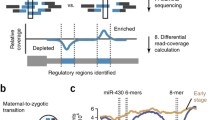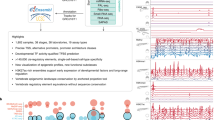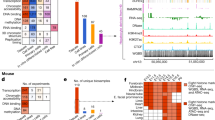Abstract
Identification of cis-regulatory elements, such as enhancers and promoters, is very important not only for analysis of gene regulatory networks but also as a tool for targeted gene expression experiments. In this chapter, we introduce an easy but reliable approach to predict enhancers of a gene of interest by comparing mammalian and Xenopus genome sequences, and to examine their activity using a co-transgenesis technique in Xenopus embryos. Since the bioinformatics analysis utilizes publically available web tools, bench biologists can easily perform it without any need for special computing capability. The co-transgenesis assay, which directly uses polymerase chain reaction products, quickly screens for the activity of the candidate elements in a cloning-free manner.
Access this chapter
Tax calculation will be finalised at checkout
Purchases are for personal use only
Similar content being viewed by others
References
Wasserman WW, Sandelin A (2004) Applied bioinformatics for the identification of regulatory elements. Nat Rev Genet 5:276–287
Pennacchio LA et al (2006) In vivo enhancer analysis of human conserved non-coding sequences. Nature 444:499–502
Woolfe A et al (2005) Highly conserved non-coding sequences are associated with vertebrate development. PLoS Biol 3:e7
Lettice LA et al (2003) A long-range Shh enhancer regulates expression in the developing limb and fin and is associated with preaxial polydactyly. Hum Mol Genet 12:1725–1735
Sagai T et al (2004) Phylogenetic conservation of a limb-specific, cis-acting regulator of Sonic hedgehog (Shh). Mamm Genome 15:23–34
Benko S et al (2009) Highly conserved non-coding elements on either side of SOX9 associated with Pierre Robin sequence. Nat Genet 41:359–364
Fisher S et al (2006) Conservation of RET regulatory function from human to zebrafish without sequence similarity. Science 312:276–279
Visel A et al (2009) ChIP-seq accurately predicts tissue-specific activity of enhancers. Nature 457:854–858
Hellsten U et al (2010) The genome of the Western clawed frog Xenopus tropicalis. Science 328:633–636
Kasahara M et al (2007) The medaka draft genome and insights into vertebrate genome evolution. Nature 447:714–719
Canestro C, Yokoi H, Postlethwait JH (2007) Evolutionary developmental biology and genomics. Nat Rev Genet 8:932–942
Ogino H, Fisher M, Grainger RM (2008) Convergence of a head-field selector Otx2 and Notch signaling: a mechanism for lens specification. Development 135:249–258
Ovcharenko I et al (2004) ECR Browser: a tool for visualizing and accessing data from comparisons of multiple vertebrate genomes. Nucleic Acids Res 32:W280–W286
Schwartz S et al (2003) MultiPipMaker and supporting tools: alignments and analysis of multiple genomic DNA sequences. Nucleic Acids Res 31:3518–3524
Larkin MA et al (2007) Clustal W and Clustal X version 2.0. Bioinformatics 23:2947–2948
Stathopoulos A, Levine M (2005) Genomic regulatory networks and animal development. Dev Cell 9:449–462
Loots GG, Ovcharenko I (2004) rVISTA 2.0: evolutionary analysis of transcription factor binding sites. Nucleic Acids Res 32:W217–W221
Sandelin A, Wasserman WW, Lenhard B (2004) ConSite: web-based prediction of regulatory elements using cross-species comparison. Nucleic Acids Res 32:W249–W252
Portales-Casamar E et al (2010) JASPAR 2010: the greatly expanded open-access database of transcription factor binding profiles. Nucleic Acids Res 38:D105–D110
Sive H, Grainger R, Harland R (2000) Early development of Xenopus laevis—a laboratory manual. Cold Spring Harbor Laboratory Press, New York
Kost TA, Theodorakis N, Hughes SH (1983) The nucleotide sequence of the chick cytoplasmic β-actin gene. Nucleic Acids Res 11:8287–8301
Navratilova P et al (2009) Systematic human/zebrafish comparative identification of cis-regulatory activity around vertebrate developmental transcription factor genes. Dev Biol 327:526–540
Kleinjan DA et al (2006) Long-range downstream enhancers are essential for Pax6 expression. Dev Biol 299:563–581
Xu PX et al (1999) Regulation of Pax6 expression is conserved between mice and flies. Development 126:383–395
Waterhouse AM et al (2009) Jalview version 2—a multiple sequence alignment editor and analysis workbench. Bioinformatics 25:1189–1191
Rada-Iglesias A et al (2011) A unique chromatin signature uncovers early developmental enhancers in humans. Nature 470:279–283
Noyes MB et al (2008) Analysis of homeodomain specificities allows the family-wide prediction of preferred recognition sites. Cell 133:1277–1289
Lehman CW, Trautman JK, Carroll D (1994) Illegitimate recombination in Xenopus: characterization of end-joined junctions. Nucleic Acids Res 22:434–442
Sambrook J, Russell D (2001) Molecular cloning: a laboratory manual, 3rd edn. Cold Spring Harbor Laboratory Press, New York
Ogino H, Ochi H (2009) Resources and transgenesis techniques for functional genomics in Xenopus. Dev Growth Differ 51:387–401
Ogino H, McConnell WB, Grainger RM (2006) High-throughput transgenesis in Xenopus using I-SceI meganuclease. Nat Protoc 1:1703–1710
Kammandel B et al (1999) Distinct cis-essential modules direct the time-space pattern of the Pax6 gene activity. Dev Biol 205:79–97
Acknowledgements
This work was supported by the Global COE Program in NAIST (Frontier Biosciences: strategies for survival and adaptation in a changing global environment), Grant-in-Aid for Scientific Research (C) (20579002 and 23570256) from JSPS and Grant-in-Aid for Scientific Research on Innovative Areas (21200064) from MEXT, Japan, to H. Ogino, by Grant-in-Aid for Young Scientists (B) (21770234) from JSPS and Research for Promoting Technological Seeds (A) (10-099) from JST, Japan, to H. Ochi, and by CREST (JST). This work was also supported by NIH grants EY00675, EY017400, EY018000, and RR013221 to R. Grainger.
Author information
Authors and Affiliations
Corresponding author
Editor information
Editors and Affiliations
Rights and permissions
Copyright information
© 2012 Springer Science+Business Media, LLC
About this protocol
Cite this protocol
Ogino, H., Ochi, H., Uchiyama, C., Louie, S., Grainger, R.M. (2012). Comparative Genomics-Based Identification and Analysis of Cis-Regulatory Elements. In: HOPPLER, S., Vize, P. (eds) Xenopus Protocols. Methods in Molecular Biology, vol 917. Humana Press, Totowa, NJ. https://doi.org/10.1007/978-1-61779-992-1_15
Download citation
DOI: https://doi.org/10.1007/978-1-61779-992-1_15
Published:
Publisher Name: Humana Press, Totowa, NJ
Print ISBN: 978-1-61779-991-4
Online ISBN: 978-1-61779-992-1
eBook Packages: Springer Protocols




